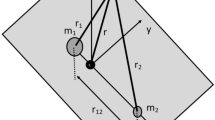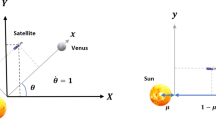Abstract
Moons of the outer planets harbor great treasures of science, but landing on these bodies to study them up-close is a very difficult task. Two characteristics of an approach-trajectory that would help enable such a mission are: (1) the spacecraft can observe its target site prior to landing, and (2) the spacecraft can abort the landing in the event of a problem and easily come back later. Each of these requirements relies on repeatability in the multi-body problem, which is non-trivial to achieve. In the current work, stable and nearly-stable periodic orbits about Europa which offer solutions to the problem of repeatability for landing are studied. 17 total solutions are identified in a perturbed three-body problem which accounts for \(J_2\) and \(C_{22}\) of Europa.
















Similar content being viewed by others
References
Bury, L., McMahon, J.: Landing trajectories to moons from the unstable invariant manifolds of periodic libration point orbits. In: AIAA SciTech, Orlando, FL, pp. 1–12 (2020). https://doi.org/10.2514/6.2020-2181
Beksinski, Jr., D.E.: Abort trajectories for manned lunar missions. Ph.D. thesis, University of Maryland (2007). https://hdl.handle.net/1903/4270
Huang, W., Xi, X., Wang, W.: Characteristic analysis and design of near moon abort trajectory for manned lunar landing mission. Sci. China Technol. Sci. 53(11), 3129–3137 (2010). https://doi.org/10.1007/s11431-010-4118-x
Senent, J.S.: Fast calculation of abort return trajectories for manned missions to the Moon. In: AIAA/AAS Astrodynamics Specialists Conference, AIAA 2010-8132 (2010). https://doi.org/10.2514/6.2010-8132
Xi, X.N., Huang, W.D., Wang, W.: Review on abort trajectory for manned lunar landing mission. Sci. China Technol. Sci. 53(10), 2691–2698 (2010). https://doi.org/10.1007/s11431-010-4092-3
Jesick, M.: Abort options for human missions to earth-moon halo orbits. In: AAS Astrodynamics Specialists Conference, pp. 1–21 (2011)
Paskowitz, M.E., Scheeres, D.J.: Design of science orbits about planetary satellites: application to Europa. J. Guid. Control. Dyn. 29(5), 1147–1158 (2006). https://doi.org/10.2514/1.19464
Lara, M., Russell, R., Villac, B.: Classification of the distant stability regions at Europa. J. Guid. Control. Dyn. 30(2), 409–418 (2007). https://doi.org/10.2514/1.22372
Lara, M., Russell, R.: Computation of a science orbit about Europa. J. Guid. Control. Dyn. 30(1), 259–263 (2007). https://doi.org/10.2514/1.22493
Lara, M.: Simplified equations for computing science orbits around planetary satellites. J. Guid. Control. Dyn. 31(1), 172–181 (2008). https://doi.org/10.2514/1.31107
Bury, L., McMahon, J.: The effect of zonal harmonics on dynamical structures in the circular restricted three-body problem near the secondary body. Celest. Mech. Dyn. Astron. 132, 45 (2020). https://doi.org/10.1007/s10569-020-09983-3
Burša, M.: Figure and dynamic parameters of synchronously orbiting satellites in the solar system. Bull. Astron. Inst. Czechoslov. 40(2), 125–130 (1989)
Roy, A.E.: Orbital Motion, 4th edn. Institute of Physics Publishing, Bristol (2005)
Koon, W.S., Lo, M.W., Marsden, J.E., Ross, S.D.: Dynamical Systems, the Three-Body Problem, and Space Mission Design. Marsden Books, Karori (2006)
Williams, D.R.: Jovian satellite fact sheet. In: NSSDCA, NASA Goddard Space Flight Center (2018). https://nssdc.gsfc.nasa.gov/planetary/factsheet/joviansatfact.html
Russell, R.P., Lara, M.: Repeat ground track lunar orbits in the full-potential plus third-body problem. In: AIAA/AAS Astrodynamics Specialist Conference, Keystone, Colorado (2006). https://doi.org/10.2514/6.2006-6750
Broucke, R.: Stability of periodic orbits in the elliptic, restricted three-body problem. AIAA J. 7(6), 1003–1009 (1969). https://doi.org/10.2514/3.5267
Szebehely, V.: Theory of Orbits—The Restricted Problem of Three Bodies. Academic Press, New York (1967)
Restrepo, R.L.: Patched periodic orbits: a systematic strategy for low-energy trajectory and moon tour design. Ph.D. thesis (2018)
Lo, M.: Low-energy interplanetary transfers using Lagrangian points: transport throughout the solar system using the invariant manifolds of unstable orbits generated by the Lagrange points. Filed New Technology Report NPO-20377. Tech. rep. (1999)
Lo, M.W., Ross, S.D.: Low energy interplanetary transfers using invariant manifolds of L1, L2, and Halo orbits. In: NASA Tech Brief, vol. 23 (1999). https://doi.org/10.1038/517528a
Koon, W.S., Lo, M.W., Marsden, J.E., Ross, S.D.: Heteroclinic connections between periodic orbits and resonance transitions in celestial mechanics. Chaos 10(2), 427–469 (2000). https://doi.org/10.1063/1.166509
Gómez, G., Koon, W.S., Lo, M.W., Marsden, J.E., Masdemont, J., Ross, S.D.: Connecting orbits and invariant manifolds in the spatial restricted three-body problem. Nonlinearity 17, 1571–1606 (2004). https://doi.org/10.1088/0951-7715/17/5/002
Parker, J.S.: Low-energy ballistic lunar transfers. Ph.D. thesis, University of Colorado Boulder (2007)
Russell, R.P., Lam, T.: Designing ephemeris capture trajectories at Europa using unstable periodic orbits. J. Guid. Control. Dyn. 30(2), 11–13 (2007). https://doi.org/10.2514/1.22985
Anderson, R.L., Lo, M.W.: Role of invariant manifolds in low-thrust trajectory design. J. Guid. Control. Dyn. 32(6), 1921–1930 (2009). https://doi.org/10.2514/1.37516
Davis, K.E., Anderson, R.L., Scheeres, D.J., Born, G.H.: The use of invariant manifolds for transfers between unstable periodic orbits of different energies. Celest. Mech. Dyn. Astron. 107(4), 471–485 (2010). https://doi.org/10.1007/s10569-010-9285-3
Anderson, R.L., Parker, J.S.: Comparison of low-energy lunar transfer trajectories to invariant manifolds. Celest. Mech. Dyn. Astron. 115, 311–331 (2013). https://doi.org/10.1007/s10569-012-9466-3
Parker, J.S., Anderson, R.L., Simon, M.K.: Low-Energy Lunar Trajectory Design, Deep Space Communications and Navigation Systems Center of Excellence. Jet Propulsion Laboratory, Pasadena (2013)
Anderson, R.L., Lo, M.W.: Spatial approaches to moons from resonance relative to invariant manifolds. Acta Astronaut. 105(1), 355–372 (2014). https://doi.org/10.1016/j.actaastro.2014.09.015
Anderson, R.L.: Approaching moons from resonance via invariant manifolds. J. Guid. Control Dyn. (2015). https://doi.org/10.2514/1.G000286
Hernandez, S., Restrepo, R.L., Anderson, R.L.: Connecting resonant trajectories to a Europa capture through Lissajous staging orbits. In: AAS/AIAA Astrodynamics Specialists Conference, Maui, HI (2019)
Sharma, R.K., Rao, P.V.S.: Collinear Equilibria and Their Characteristic Exponents in the Restricted Three-Body Problem When the Primaries are Oblate Spheroids. Applied Mathematics Division, Vikram Sarabhai Space Centre (1974)
Bhatnagar, K.B., Hallan, P.P.: Effect of perturbed potentials on the stability of libration points in the restricted problem. Celest. Mech. 20, 95–103 (1979). https://doi.org/10.1007/BF01230231
Elshaboury, S.M.: The equilibrium solutions of restricted problem of three axisymmetric rigid bodies. Earth Moon Planet. 45, 205–211 (1989). https://doi.org/10.1007/BF00057743
Arredondo, J.A., Guo, J., Stoica, C., Tamayo, C.: On the restricted three body problem with oblate primaries. Astrophys. Space Sci. 341(2), 315–322 (2012). https://doi.org/10.1007/s10509-012-1085-7
Sharma, R.K.: Periodic orbits of collision in the restricted problem of three bodies, when the bigger primary is slowly rotating oblate spheroid. Indian Natl. Sci. Acad. 5(2) (1972)
Sharma, R.K.: Periodic orbits of collision in the restricted problem of three bodies in a three-dimensional coordinate system, when the bigger primary is an oblate spheroid. Indian Natl. Sci. Acad. 5(2) (1972)
Sharma, R.K.: Periodic orbits of collision in the restricted problem of three bodies, when the bigger primary is an oblate spheroid. Indian Natl. Sci. Acad. 4(4) (1972)
Mittal, A., Ahmad, I., Bhatnagar, K.B.: Periodic orbits generated by Lagrangian solutions of the restricted three body problem when one of the primaries is an oblate body. Astrophys. Space Sci. 319(1), 63–73 (2009). https://doi.org/10.1007/s10509-008-9942-0
Abouelmagd, E.I., Asiri, H.M., Sharaf, M.A.: The effect of oblateness in the perturbed restricted three-body problem. Meccanica 48(10), 2479–2490 (2013). https://doi.org/10.1007/s11012-013-9762-3
Abouelmagd, E.I., Alhothuali, M.S., Guirao, J.L., Malaikah, H.M.: Periodic and secular solutions in the restricted three-body problem under the effect of zonal harmonic parameters. Appl. Math. Inf. Sci. 9(4), 1659–1669 (2015)
Salazar, F., Alkhaja, A., Fantino, E., Alessi, E.M.: Science orbits in the Saturn-Enceladus circular restricted three-body problem with oblate primaries. Acta Astronaut. 180, 398–416 (2021). https://doi.org/10.1016/j.actaastro.2020.12.045
Markellos, V.V., Douskos, C.N., Dimitriadis, K.P., Perdios, E.A.: Lyapunov orbits and asymptotic connections in the hill problem with oblateness. In: Recent Advances in Mechanics and Related Fields, Volume in Honour of Prof. Constantine L. Goudas (2004)
Bury, L., McMahon, J., Lo, M.: A study of periodic orbits near Europa. Celest. Mech. Dyn. Astron. 134, 27 (2022). https://doi.org/10.1007/s10569-022-100
Restrepo, R.L., Russell, R.P.: A database of planar axisymmetric periodic orbits for the solar system. Celest. Mech. Dyn. Astron. 130(7), 1–24 (2018). https://doi.org/10.1007/s10569-018-9844-6
Bury, L., McMahon, J., Lo, M.: Low-energy boundaries on vertical motion near the secondary body. Submitted to J. Astronaut. Sci. (2021)
Hénon, M.: Generating Families in the Restricted Three-Body Problem. Springer, Berlin (1997)
Howell, K.C.: Three-dimensional, periodic, ‘halo’ orbits. Celest. Mech. 32(1), 53–71 (1984). https://doi.org/10.1007/BF01358403
The Math Works Inc.: MATLAB R2021a (2021)
Bury, L., McMahon, J., Lo, M.W.: Periodic orbits as viable landing solutions with an abort option at Europa. In: AAS Astrodynamics Specialists Conference, Big Sky, MT, pp. 1–18 (2021)
Lara, M., San Juan, J.F.: Dynamic behavior of an orbiter around Europa. J. Guid. Control. Dyn. 28(2), 291–297 (2005). https://doi.org/10.2514/1.5686
Funding
Part of this research was carried out at the University of Colorado at Boulder under a NASA Space Technology Research Fellowship (80NSSC18K1183). Part of this research was carried out at the Jet Propulsion Laboratory, California Institute of Technology, under a contract with the National Aeronautics and Space Administration (80NSSC18K1183).
Author information
Authors and Affiliations
Corresponding author
Ethics declarations
Conflict of interest
On behalf of all authors, the corresponding author states that there is no conflict of interest.
Rights and permissions
Springer Nature or its licensor (e.g. a society or other partner) holds exclusive rights to this article under a publishing agreement with the author(s) or other rightsholder(s); author self-archiving of the accepted manuscript version of this article is solely governed by the terms of such publishing agreement and applicable law.
About this article
Cite this article
Bury, L., McMahon, J. & Lo, M. Perturbed Periodic Orbits as Landing Solutions with an Abort Option at Europa. J Astronaut Sci 69, 1493–1513 (2022). https://doi.org/10.1007/s40295-022-00359-3
Accepted:
Published:
Issue Date:
DOI: https://doi.org/10.1007/s40295-022-00359-3




